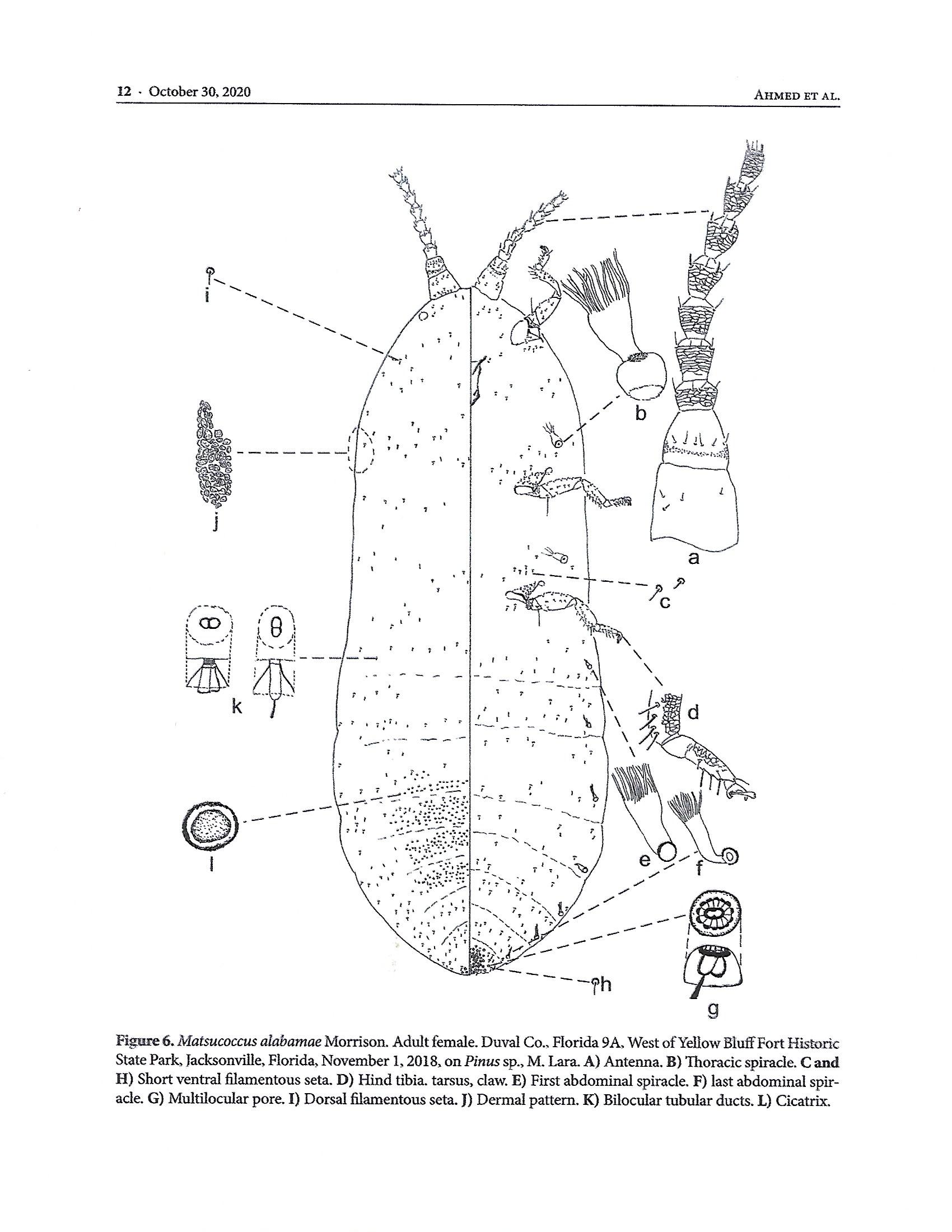Valid Names Results
Matsucoccus alabamae Morrison, 1939 (Matsucoccidae: Matsucoccus)Nomenclatural History
- Matsucoccus alabamae Morrison 1939: 2. Type data: USA: Alabama, Calhoun, on Pinus sp., March 16 & 31, April 21, 1902; collected A.M. Troyer.. Lectotype, female and first instar, by subsequent designation Type depository: Davis: The Bohart Museum of Entomology, University of California, California, USA; Washington: United States National Entomological Collection, U.S. National Museum of Natural History, District of Columbia, USA; accepted valid name Illustr.
- Matsucoccus alabama Morrison, 1939; Mendel, Carmi & Podoler 1991: 503. misspelling of species epithet
Common Names
Ecological Associates
Hosts:
Families: 1 | Genera: 1
- Pinaceae
- Pinus | Morris1939
- Pinus elliottii | AhmedMi2020
- Pinus palustris | AhmedMi2020
- Pinus taeda | AhmedRaMo2020
Foes:
Families: 1 | Genera: 1
- Anthocoridae
- Elatophilus pinophilus | MendelCaPo1991
Geographic Distribution
Countries: 1
- United States
- Alabama | Morris1939
- Florida | AhmedMi2020
- Georgia | AhmedMi2020
- South Carolina | AhmedMi2020
- Tennessee | AhmedMi2020
- Virginia | AhmedMi2020
Keys
- AhmedRaMo2020: pp.8 ( Adult (F) ) [Eastern U.S.]
- RayWi1991: pp.190 ( Adult (F) ) [North America]
- RayWi1984: pp.768-769 ( Adult (F) ) [North America]
- Boraty1952a: pp.321-324 ( Adult (F) ) [World]
Remarks
- Systematics: Four species, including M. banksianae Ray & Williams from Minnesota, M. californicus Morrison from California, M. oocarpae Ray & Williams from Guatemala and M. vexillorum Morrison from Arizona, are morphologically similar to M. alabamae (Ray and Williams 1991). Adult females of these species all lack fleshy sensory setae on the fifth antennal segment, have well developed legs and antennae, possess multilocular disc pores at the apex of the abdomen and possess only one size of body setae, and each species feeds on pines of a single subsection (McKenzie 1943, Ray and Williams 1991). Matsucoccus alabamae differs from the others in that the adult female cicatrices are usually in four distinct bands, the anterior one is about half of the width of the other bands, the body setae are all about the same size in the adult and third-instar males, and they usually feed on pines of the subsection Australes (Ray and Williams 1984).
- Structure: Adult females are light yellow or brown, wingless and have unusually large and characteristically shaped antennae. First instars transform into an intermediate legless cyst resembling a brown pearl. Preadult males resemble females with large antennae but are smaller and slenderer. Adult males have one pair of obvious wings and a series of long crystalline rods at the rear of the body. (Ahmed & Miller, 2020) Third-instar male has one size of seta on venter, setae anterior of metacoxae 8–11 μm long; with eight or fewer bilocular tubular ducts on dorsum of abdominal segment III; developing genitalia at posterior end of abdomen; abdominal spiracles usually similar in size; fleshy setae present on distal four antennal segments. (Ahmed, et al., 2020)
- Biology: Matsucoccus alabamae overwinters in the second-instar cyst beneath bark scales on the trunk of the host. In March, the third-instar males emerge from the cysts, settle, feed beneath bark and produce a waxy sac in which they molt to the fourth-instar pupa. Adult males emerge and begin to actively seek out females. Adult females emerge from the cyst, move to the outer surface of the tree trunk, or between the edges of bark scales, and extend the posterior end of their abdomen as far from the trunk as possible. Adult males run rapidly up and down the trunk and orient to the posterior apex of the female to copulate. After copulation is complete, adult females crawl beneath loose bark flakes, near a scar or at the base of a branch, before producing a waxy ovisac in which 501-860 eggs are laid. Copulation is necessary for oviposition; unmated females do not produce eggs. As females deposit eggs, their bodies contract and fold so that when all eggs are deposited, the females are reduced to less than a third of their original size. (Ahmed & Miller, 2020)
- General Remarks: Because Morrison (1939) did not specifically mention a holotype in the original description, the lectotype, was designated in Ahmed, et al. (2020). It is the single mounted adult female from the syntype series mounted on a slide and labeled as follows: left label: “9582 Matsucoccus/ alabamae/ Holotype/ On pine/ Calhoun, Ala./ March 16, 1902” right label “Matsucoccus/ alabamae/ Morrison/ lectotype/ desig. by Ahmed et al. 2020” (deposited at USNM).
Illustrations
Citations
- AhmedMi2020: biology, control, diagnosis, distribution, economic importance, host,
- AhmedRaMo2020: DNA, description, diagnosis, illustration, key, life history, male, nymph,
- BenDov2005a: catalog, distribution, host, taxonomy, 115-116
- BodenhNe1955: taxonomy, 10
- Boraty1952: taxonomy, 324
- Foldi2001a: taxonomy, 207
- Foldi2005: taxonomy, 165
- MechAsCr2013: distribution, host, 2391-2392
- MendelCaPo1991: biological control, distribution, host, 502-507
- Morris1939: description, distribution, host, taxonomy, 2-3
- Rieux1975: distribution, host, taxonomy, 157-168
- Tang1978: taxonomy, 165
- TangWuLi1997: taxonomy, 17-23
- Young1980: taxonomy, 183



